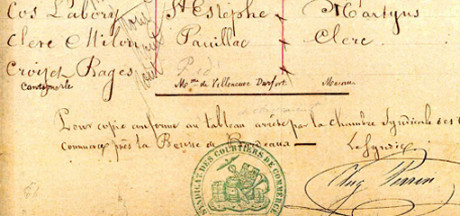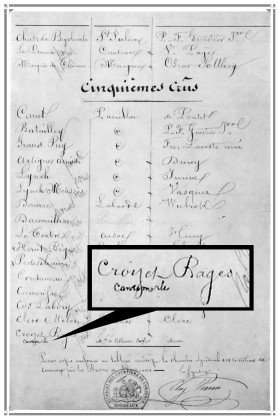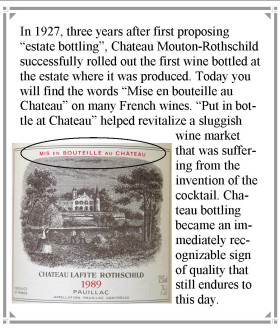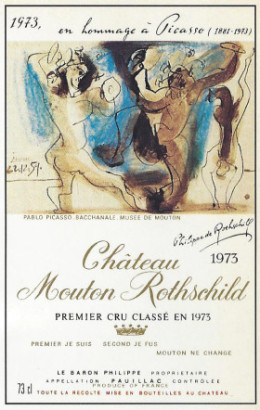Ch Ch Ch Changes to the 1855 Bordeaux Wine Classification
Chapter Sixteen, Part Four.
“Every time I thought I’d got it made, it seemed the taste was not so sweet.” David Bowie
 The authors of the Official Bordeaux Wine Classification made an unusual entry on the original handwritten document drawn up in 1855. Cantemerle (now known as Chateau Cantemerle) appears to have been written on the bottom of the historic list in a different hand than the other entries. It is squeezed into a narrow space below the Fifth Growth ranked Croizet-Bages (formerly the bottommost entry) and looks like an afterthought on the part of the authors. Cantemerle was also left off the map of estates that was displayed at the 1855 exposition, although it has appeared on every subsequent map since 1856.
The authors of the Official Bordeaux Wine Classification made an unusual entry on the original handwritten document drawn up in 1855. Cantemerle (now known as Chateau Cantemerle) appears to have been written on the bottom of the historic list in a different hand than the other entries. It is squeezed into a narrow space below the Fifth Growth ranked Croizet-Bages (formerly the bottommost entry) and looks like an afterthought on the part of the authors. Cantemerle was also left off the map of estates that was displayed at the 1855 exposition, although it has appeared on every subsequent map since 1856.
Chateau Cantemerle maintains the oversight occurred because they traditionally sold their entire production to Holland, bypassing the negociants  who created the classification. These brokers had recorded the selling price of Cantemerle just six times in the 80 years prior to 1854 and since they had little idea of Cantemerle’s price they weren’t sure how to rank it. In 1854 Cantemerle did release its production to the traditional Bordeaux market through the negociants and the recorded selling price was higher than Croizet-Bages, the Fifth Growth estate that preceded it on the document.
who created the classification. These brokers had recorded the selling price of Cantemerle just six times in the 80 years prior to 1854 and since they had little idea of Cantemerle’s price they weren’t sure how to rank it. In 1854 Cantemerle did release its production to the traditional Bordeaux market through the negociants and the recorded selling price was higher than Croizet-Bages, the Fifth Growth estate that preceded it on the document.
Today, Chateau Cantemerle represents one of the great values in classified Bordeaux and you don’t have to travel to Holland to find a bottle. Aside from Cantemerle’s late addition to the 1855 Classification, and the changes that occurred due to property transfers or name changes, there has been only one significant alteration to the classification since 1855.
First, I am. Second, I was. Mouton does not change.
We’ll probably never know why Mouton-Rothschild wasn’t granted Premier Cru (lit. First Growth) status in the Official Bordeaux Wine Classification of 1855. The levels of the classification were based on the market price of each wine and perhaps Mouton-Rothschild was in a pricing slump at the time, or maybe there was a nationalistic backlash towards the new English owner of the estate, Baron Nathaniel de Rothschild.
What we do know is that in 1973, after a grueling crusade by Nathaniel’s descendent Baron Philippe de Rothschild, Mouton-Rothschild was elevated to Premier Cru status. Rothschild’s efforts were motivated by more than the entrenched belief that his beloved Mouton-Rothschild belonged in the top rank with Chateaux Lafite, Latour, Margaux and Haut-Brion. It was actually a slight by these estates that made the Baron intensify his efforts to change history.
The tale began fifty-one years earlier, when Philippe Rothschild assumed managerial responsibilities at the family’s neglected, Second Growth estate. The brash, 20-year-old aristocrat had the revolutionary idea of controlling the quality and pedigree of his wines from start to finish. What he had in mind was the unheard of practice of bottling and aging his wine at the chateau. Today this sounds like common sense but prior to 1927 this process was handled entirely by the negociants.
Rothschild was aware of the uproar this innovation would create in the established wine trade so to gather support he recruited the proprietors of the First Growth estates, Lafite, Latour, Margaux and Haut-Brion. Lafite was owned by Rothschild’s distant cousins Édouard and Robert Rothschild and they did not always see eye to eye with his side of the family. After initially rejecting the idea, Édouard and Robert eventually came to see the wisdom in  estate bottling and agreed to support the plan. Rothschild proposed all five estates put their commitment in writing and call themselves the “Association of Five”. Even though they were in agreement, the manager of Lafite informed Rothschild that his cousins Édouard and Robert never signed anything, as their word was good enough. The others signed the document, Lafite never did.
estate bottling and agreed to support the plan. Rothschild proposed all five estates put their commitment in writing and call themselves the “Association of Five”. Even though they were in agreement, the manager of Lafite informed Rothschild that his cousins Édouard and Robert never signed anything, as their word was good enough. The others signed the document, Lafite never did.
The Association of Five held monthly meetings, but one day in 1952 Rothschild received word that the other four had met behind his back and dissolved the Association of Five. At the urging of Rothschild’s cousin Élie, now running the affairs at Lafite-Rothschild, the Association of Five was replaced by the Association of Four! Mouton-Rothschild, being a lowly Second Growth, was no longer welcome in the elite company of the First Growths.
In his 1984 autobiography, Rothschild described his reaction to the news;
I went into a tailspin, threw away the morning paper – France’s war in Indo-China was going badly; mine had just been declared. I knew what had brought things to a head – Mouton’s success. My wines were fetching top prices everywhere, sometimes more than the other Premier Crus, and Mouton-Cadet¹ was the most popular Bordeaux wine in the trade. This was particularly resented.²
Lafite-Rothschild, Latour, Margaux and Haut-Brion used the Bordeaux Wine Classification of 1855 as justification for kicking Rothschild out of the club he had created. Rothschild decided to challenge the very foundation of their elitism. He wrote about his plan in his autobiography;
Since Élie and whoever else he’d managed to win over, were only using the old classement to boot me out, there was only one way to put a stop to their capers. Ditch the 1855 altogether, and replace it with a new, up-to-date table, with Mouton in its rightful place. That would fix them. I knew that old documents with seals on them were highly prized in France, until they finished up in the flea market. I couldn’t have imagined that it would take me twenty years to get this one torn up.³
Rothschild waged war with the established wine trade, regulators and First Growth estates. To show his contempt for Mouton’s ranking in the 1855 Classification he created the motto, “Premier ne puis, second ne daigne, Mouton suis.” (First, I cannot be. Second, I do not deign to be. Mouton I am.).
Rothschild’s attempts to change the 1855 Classification dragged on for years. He relentlessly pursued his goal, doggedly meeting with five successive ministers of agriculture. Under a new president in 1969, reforms in the INAO were finally authorized. However, it was decided that no changes to the Classification could occur without the consent of the affected property owners, which meant Rothschild had to convince the Association of Four to drop their opposition.
Rothschild’s chances finally improved when Chateaux Latour and Haut-Brion were purchased by an Englishman and an American respectively. The new owners approached Margaux and Rothschild’s cousin Élie at Lafite-Rothschild and shortly afterwards Philippe Rothschild received a letter stating the four  First Growth estates were no longer opposed to Mouton-Rothschild being accepted as a Premier Cru. All of the roadblocks had been cleared and on June 21st, 1973, the Official Bordeaux Wine Classification of 1855 was changed, granting Mouton-Rothschild Premier Cru status. No other changes in the Classification were implemented.
First Growth estates were no longer opposed to Mouton-Rothschild being accepted as a Premier Cru. All of the roadblocks had been cleared and on June 21st, 1973, the Official Bordeaux Wine Classification of 1855 was changed, granting Mouton-Rothschild Premier Cru status. No other changes in the Classification were implemented.
A new motto was adopted and proudly displayed on the label of the 1973 Chateau Mouton-Rothschild; “Premier je suis, Second je fus, Mouton ne change.” (First, I am. Second, I was. Mouton does not change.). The slogan was placed just below the larger declaration; PREMIER CRU CLASSÉ EN 1973!
¹ Mouton-Cadet is a value priced Bordeaux brand created by Philippe Rothschild. According to Rothschild’s memoirs, the Association of Four so resented Mouton-Cadet that they offered to drop their opposition to Mouton’s attempts at changing the 1855 Classification if Philippe would take Mouton-Cadet off the market.
² Littlewood, Joan. (1984) Baron Philippe The Very Candid Autobiography of Baron Philippe de Rothschild, 250
³ Littlewood, Joan. (1984) Baron Philippe The Very Candid Autobiography of Baron Philippe de Rothschild, 253






















